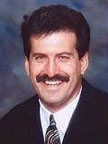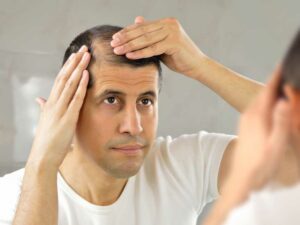 Dr. Matt Leavitt is the head of Medical Hair Restoration, one of the largest hair restoration clinics in the country, primarily located in Florida and the east coast. He also serves as Vice President of the American Board of Hair Restoration Surgery, the new certification board for hair transplantation. Beyond that, he is also chairman of the World Association of Hair Restoration Surgeons. Dr. Leavitt is also coordinating the WAHRS Live Surgery Workshop in March of 1998, which will help to educate transplant doctors in the latest hair transplant techniques.
Dr. Matt Leavitt is the head of Medical Hair Restoration, one of the largest hair restoration clinics in the country, primarily located in Florida and the east coast. He also serves as Vice President of the American Board of Hair Restoration Surgery, the new certification board for hair transplantation. Beyond that, he is also chairman of the World Association of Hair Restoration Surgeons. Dr. Leavitt is also coordinating the WAHRS Live Surgery Workshop in March of 1998, which will help to educate transplant doctors in the latest hair transplant techniques.
regrowth: Are you ready for the live surgical workshop?
Dr. Leavitt: It is so much work. We’re going to do about 21 live surgeries believe it or not and I kind of got… it has even evolved further… I’ve got the top guys from all over the world coming in doing all kinds of research and interestingly enough the cases that we do here we’re going to take some of the research that we’re doing and at the international meeting which in terms of attendees is the largest meeting which will be in Washington in September we’re going to have a separate symposium where I actually show pictures and present a lot of these patients at that meeting.
regrowth: Who’s going to be presenting? do you know yet?
Dr. Leavitt: I’ll give you kind of a day to day quick synopsis. The first day which is Wednesday I’m going to have a research kind of update on kind of the leading people in the world on research for the first probably two to three hours. I’ve got Dr. Kim who is probably the most knowledgeable person on cloning speaking on cloning. Dr. Mayer, who gave the feature presentation on Finasteride and Propecia over in Barcelona, will be talking on that. I’m going to talk on Tricomin. I’ve been working on that closely with ProCyte… both during the course of the workshop but I’m actually going to show the Shampoo and talk about the shampoo. Marty Schweiger who is one of the top researchers in hair is going to talk about the pathophysiology of hairloss and about the top 80 compounds that are related to hair loss and what their effect is. Dr. Weigand will be talking on Dermatopathology. Then we’re going to have a beginner’s workshop which is more basic. Paul Cotteril who is the chairman for the big meeting this year will be the moderator. Dr. Shapiro will give a mega-sessions discussion. Dr. Mangubat will talk about reductions, and I’m going to talk about setting up a practice.
Thursday morning… what we do in these sessions is starting with the actual live surgery on Thursday, Friday and Saturday is that at breakfast and lunch we talk about what we’re going to do and then after breakfast whatever we talked about we go do. So for instance, Thursday morning I’m going to have a separate part at breakfast just on graft preparation and we’re going to show all the different ways of preparing grafts. In other words we’re going to compare backlighting vs. the dissecting microscope, cutting pearls, automated graft-cutters, a lot of stuff that has never been shown or discussed… we’re also going to talk about minimizing scarring. As far as names in terms of graft preparation, probably Limmer or Seager will do dissecting microscope.
Donor removal… there’s a new procedure that we’re kind of working with that Frechet and I have discussed for about the last year and a half… he’ll talk on that. I’ll talk on some pearls for suturing and on stapling Arnold will discuss that. As far as actual surgeries that morning, a mega-session will be done by Shapiro and Rose, and then a case where we show all the different ways of graft cutting – we’ll actually show it – will be a whole team of people. I’m actually going to take the tissue, Arnold will staple half of the head and I’ll suture the other half and we’ll compare the healing in both and comfort levels and all those sorts of things. As far as cutting the grafts, Rose will have a team that will do some with backlighting, I’ll have a team that does it more traditionally with magnification and lighting, and Seager will do the dissecting microscope and we’ll compare those. At lunch we’re going to have a laser symposium which Dr. Ziering will put on along with DiBernardo and Avram and then we’ll also talk about hair removal with Brugerman, a doctor from Argentina. As far as placement goes we’ll also talk about different placement techniques and we have Dr. Leonard will moderate, Rassman will show his dense packing and rapid fire instrument, Haber will discuss small punches and microslits, Dr. Lariss who is another MHR doctor will show 18 gauge, the choi implanter will be Dr. Ishi from Japan and Dr. Kim from Korea… we’re actually going to show all that on different patients.
The next day, Friday is almost all scalp reduction related stuff. I’m going to have Dr. Frechet moderate. I’m going to do a U-shape reduction with Perez, Nordstrom’s going to do his new procedure with his new silicone suture, which I think may be one of the biggest advances we’ve had in years on scalp reductions. Straub’s going to do a reduction, and Dr. Cohen’s going to do his reduction. Frechet’s going to do an extender. In the afternoon Puig and Mangubat will do a lift, Kabaker will do a flap, Frechet will do a slot correction.
On Saturday, Frechet is going to do his new 5,000 graft procedure in three hours, and Beehner will do a frontal forelock. Mayer will be doing a female. Eyebrow and eyelashes on how to do transplant that will be Dr. Gondelman from Brazil. We’re going to demonstrate Procyte’s graftcyte and some new things postoperatively. Dr. Friedman will do a patient with a hair system. I’ll be working on a corrective patient and Dr. Epstein will give a lecture on it. Dr. Kurgis will be doing an African American. Those are some of the types of patients we’ll do on Saturday.
Sunday I’m going to have mainly panel discussions. One on marketing, one on ethics, one on new instrumentation, one on risk management, one on different types of hair cases. That’s kind of a real brief overview of the agenda.
regrowth: It’s a lot to fit into a few days.
Dr. Leavitt: It’s a very exhausting… if you talk to anybody about it, it has gotten a reputation for a) being wonderful but 2) being grueling. It is just really… it’s like 7:30 in the morning to 7 at night and it’s just nonstop but it’s all interactive so people handle it. You do leave fairly exhausted. So we’re excited about it. I think this will be our best yet. I’m really looking at a lot of comparisons and studying things with the microscope, the video microscope, comparing the different types of techniques.. So much of what we say in transplantation is anecdotal instead of really objective research data where we actually looks at things, so this puts it more into a research realm plus we still get the anecdotal and then of course the patient will tell us what they liked the best.
regrowth: Let’s start with the board of hair restoration surgery. If you could, let me know how you got involved with that?
Dr. Leavitt: Basically my initial involvement came probably 5 or 6 years ago and the first person who really discussed it with me was Shelley Friedman and at the time there was great opposition to a board and then a) a lot of people didn’t think it needed to be done, they just said ‘What’s the point?’ and b) there was a lot of politics among the different people that really were the experts of hair loss and hair transplantation. So really there wasn’t any ability to get it off the ground even though he and I tried to lobby for it among several people. Then Carlos Puig jumped on the bandwagon and got very involved and was very ‘pro’ it, and the American Hair loss Council was willing to support it. The problem is the American Hair loss Council doesn’t have that many physicians heavily involved. What started to happen was the hair transplant industry… it was in the public eye a lot more but with that came a lot more exposure of all the negatives related to the industry: the fact that there was no regulation, the fact that anybody who wanted to hang up a shingle – someone could graduate medical school, do their internship and then go out and be a hair transplant surgeon and if they had a nice ad people might see them, so once the negatives started hitting and the society started feeling some pressure because they started having to deal with a lot of bad publicity then people became a lot more interested… basically the different transplant groups were polled if they thought that this was something they’d want to be involved in and the leadership was right in the different groups at the time to get a thumbs up from their members. This all happened basically in the last two years. Bob Cattani and Marty Unger were very interested from the American Society of Hair Restoration. Frechet, Arnold and I were pro it from the World Association. The International Society, Leonard, was able to get some good support from there, then Shelley and Puig from the American Hair Loss Council, so we started to get a meeting of the minds. Trying to put it together was really a trip – getting people to say they want to do it is one thing but taking people who are extremely busy in practice and trying to get them together in laying out the outline – really I would say that Shelley Friedman, Puig, myself and Cattani were really the four that were doing a lot of the work early on as far as trying to decide what criteria would be involved. Once the actual board was formed and people were picked from different societies – and getting involved with this basically was kind of the Who’s Who in hair transplantation. Initially Frechet, Shielle, and some others were going to be involved with it but the distance to travel and be at meetings was too much. We started meeting on a regular basis. We formed the criteria and got some consensus there, then came the process of actually writing the exam, oral and written, and we wanted it to be as good an exam as possible so we hired a group out of Arizona who puts on exams for a lot of the major ABMS certifications. He coached us and guided us and we gave a tremendous amount of responsibility to everybody and it was just a lot of work, but the significant thing is that the people who went to the board review course and then took the exam all felt it was extremely fair and well put together. I think it’s something that will obviously gain a lot of momentum, in that it’s something that the public wants and it’s really needed. We need some sort of basis to at least say, ‘Hey, these people are experienced and they’ve met these minimum requirements and they have a certain fundamental knowledge both on the safety and what is appropriate hair transplantation – you certainly can’t test anybody for the artistic ability.
regrowth: Something I brought up to a couple of people on the board was certification of surgical assistants. I know you’ve had your hands full just getting the whole thing organized and getting everybody tested, but are there any set plans for what you’re going to do about that in the future?
Dr. Leavitt: We’re very interested in it. It’s been discussed. No decisions have been made. I think it’s a great idea. There’s really no place for training of surgical assistants right now other than in offices. In fact, we’ve had calls in the last three days from doctors who want to pay us to train their assistants because we do hair every day and they do it maybe two or three times a week, so there would be some advantages – we do more volume. But it’s something that would certainly help because as you have learned in transplantation, assistants play a very large role and are very, very important and if a doctor does good work but his assistants don’t do good work and the doctor really is turning his head, then the results still won’t be what they want it to be. So there’s nothing definitive, but it’s a great idea that has come across the board and it’s something that I wouldn’t be surprised if it happens in the next year or two as the board gets a litle larger.
regrowth: Where did you grow up and go to medical school and what sort of credentials and certifications do you have as a surgeon?
Dr. Leavitt: Well, I’m a Michigander. I’m from Grand Rapids, Michigan. It’s a good time to be from Michigan. I probably use the internet more checking recruiting than anything else. I went to University of Michigan for undergrad, and then I went to Michigan State for medical school. Then I did a dermatology residency… as far as hair transplantation, I actually had met Shelley Friedman when I was in first year of medical school and he was somebody who was very into hair transplantation and basically told me about who was good and who wasn’t and I went around the country working with anybody and everybody in hair transplantation even during my internship and residency, so I got interested in it very early on. In fact, about my junior year of medical school I was already working with hair transplant surgeons. Their advice to me was to go into Dermatology as it was the field that probably a) most closely defined hair transplantation and b) certainly all the training in skin surgery and hair loss would be advantageous.
regrowth: How long exactly have you been performing hair transplantations?
Dr. Leavitt: About 10 years.
regrowth: Do you have any idea how many transplant operations you’ve done in that time?
Dr. Leavitt: We at one point were counting grafts and we had done about 2 and a half million grafts. As far as patients go I can only give you the roughest of rough estimates – it’s not unusual for me to do 20-30 people a week and I’ve been doing that for years, so I guess if we do the math… 10-12,000 procedures… probably somewhere in that realm.
regrowth: And do you do reductions or other operations or just grafts?
Dr. Leavitt: No, I do other procedures also. I don’t do many reductions anymore compared to if you would have asked me four years ago – I did a tremendous number of reductions – but I do very few now. I still believe in them wholeheartedly for special patients. People who very much want the density in the back of the head and otherwise couldn’t get density. Certainly we’re very careful on who we pick and choose for scalp reductions.
regrowth: Now are you – which philosophy do you follow as far as the types of grafts you do: mini-micros, follicular units – what’s your philosophy on that?
Dr. Leavitt: My philosophy is talk to the patient. In our fellowship we train doctors on every technique. We train them on use of the microscope. We train them on what is a follicular unit. We train them on mini-slits, small punches, certainly on little punches – we train them in all the techniques. In a minute I’ll tell you what I do on my average patient, but every patient is different and the one thing that frustrates me in transplants is that everybody kind of – all of a sudden they jump on a bandwagon and that’s all they do – for a while it was like scalp reductions were in huge favor and everybody was big scalp reduction advocates then they got totally out of favor and nobody wants to do reductions. All of a sudden follicular units come on and the microscope – everybody’s doing them – now there’s a backlash starting to occur where more and more people – if you talk to the Ungers and many other people [saying] the results aren’t quite what we thought they would be with just follicular units and the microscope. People aren’t that happy about density several times. It really depends on what the patient wants – if it’s a young patient who has very little hair loss I will do just micros – smaller follicular units – into little tiny punctures – usually like an 18 gauge needle. If it’s somebody with a lot more baldness and they want a lot of density and they are committed to coming back in a reasonably short period of time then I will use minigrafts – often 1.5mm – to gain better density and I’ll put those fairly close together and I’ll come back very quickly and go in between those. Now I always put a huge zone of micrografts in front of those and I always have a zone of micrografts behind those. But I’m able to achieve a lot more density with a lot fewer grafts for these people and I think that they get happier a lot quicker as compared to the patient where I do a thousand micros on who gets nice coverage that looks natural but they’re dissatisfied in that they didn’t get as much density as they thought they’d have from a thousand grafts. So I guess my philosophy is to really get to understand what somebody wants and to try to give them as much education as possible so that they’re making a very educated decision and talk about the advantages and disadvantages of all the different options and techniques and then we make a game plan. So I’m not totally sold that one technique is always the best. I think Walter Unger did a pretty good job in his discussion that there is a lot of ways to skin a cat and really you can’t just say this is the best way or that is the best way because it’s very dependent on the patient. People with gray hair, blond hair, African Americans, they do great with minigrafts. They get tremendous coverage very well with an experienced hand. I think there’s a lot less potential risk for the patient if you’re just doing small micrografts but often you’re not giving them what they want. But for somebody who’s not experienced certainly you’re going to get in less trouble – you’re not going to have the potential to maybe have as great of scarring if you did a poor job with the others – you’re not going to use as much donor [hair]. So I think it’s very dependent on the patient is the bottom line.
regrowth: What sort of pricing scheme do you use as far as – do you do a flat rate per session, do you do it per graft, per hair…?
Dr. Leavitt: We do it per graft and there’s a sliding scale that is very dependent upon the number of grafts we’re doing. However, we are going to go basically to a per hair price. We’ve been doing a lot of research studying how many hairs it takes to achieve different things. We’ll probably be done by the workshop – we’re in the final stages. Right now we’re priced per graft but that actually is to our disadvantage because our minigrafts may be three or four sets of follicular units for instance, but people are paying the same as they are for a micrograft – a one haired micro – so it’s really not apples to apples. That’s one of the big problems in hair transplantation. There’s a lot of deception.
regrowth: It’s hard to compare prices between any two doctors or clinics.
Dr. Leavitt: It’s very, very difficult. There’s a lot of – unfortunately – baiting and switching where somebody says $4 per graft but there are several different things that you have to do to achieve that. But right now we’re by the graft but I believe that we’ll be switching to by the hair and the price will get very, very low because there’ll be the lowest common denominator. But that will make a level playing field that anybody comparing their prices to us will also have to do it at that sort of basis.
regrowth: I know it’s hard to generalize about it because every patient is different, but on average what would you say a typical session of transplants costs and how many sessions do most people generally have?
Dr. Leavitt: I would say that the typical session is somewhere between $3,500 and $5,000. There are certain people who obviously pay a lot more – I’ve got a guy on the table right now I think who’s $1,800 – so certainly a lot less. As far as the average session goes, I would say if you looked at it statistically our average patient probably has about 600 grafts and probably has at least 2 sessions. I don’t think there are many people who ultimately will have less than 1,000 grafts even if you’re doing minigrafts. I think anybody who says you can have a one session transplant is not being honest unless the patient is completely bald and only wants super thin hair. Otherwise the patients’ hair loss is going to progress. They’re going to slowly lose hair. So it’s going to become thinner and finer over a period of time and they’re going to want more hair, so even if you were able to achieve the density they wanted initially it wouldn’t ultimately be the density they wanted. Secondly there’ll be new areas, but with hair – more is always better – if you’re a patient. So I just don’t feel that many people will ultimately be happy with just one transplant even though they may go three or four years and be happy with one.
regrowth: Do you see many women coming in and is that increasing?
Dr. Leavitt: Yeah I started speaking out on women several years ago. As a matter of fact, I did a special for FOX – how many years ago was that… 4 years ago and I did a big talk on it in San Francisco and LA. We were trying to push people – because women had no place to go… they’d come to me from all over the country and say “hey we’ve been to 10 doctors and nobody says you can do anything.”
regrowth: Right, a lot of people just won’t see them.
Dr. Leavitt: I think that women are much easier candidates except for one thing – the only thing with women, any man who has male pattern hair loss is a candidate if he has realistic expectations no matter what. If you’re able to tell him what’s possible with his donor [hair] he’s a candidate. With women you can’t say that because there are obviously the Ludwig III classification – the balder women – who simply cannot have transplantation. They’re too thin in the back. If you take that aside… take the majority of the women I see, they can have one transplant and often be happy.
regrowth: Do you have many patients come in who you end up having to turn down because you recognize that they’re not going to be satisfied no matter what you do or they have some other psychological problem that’s going to keep them from getting satisfaction no matter what?
Dr. Leavitt: Very few. There certainly are some but very few. I think the number one reason we turn people down is we don’t feel their budget can match their expectations. In other words they want a lot of hair for a little budget. You know that if you do one surgery on them they may be happy but if they lose more hair they’re not going to have the budget for it and I don’t care how good of a surgeon you are, hair loss can overcome a good result. So somebody’s got to be realistic about what they actually have to budget for this in terms of both their time and money. There’s not a lot for psychological reasons – there are some. I had a guy the other day – signed up for 1,300 grafts and I had heard some things from nurses and heard some things from other staff about this guy when he had come in and I talked to him… I told him I wasn’t comfortable doing him and I gave him the names of three or four doctors who I felt could also do a good job. So that’s a case where we turned him down, but there’s not many… I’d say less than 5%.
regrowth: There’s a lot of doctors that won’t do transplants on some patients who are just too young and haven’t had enough hair loss. I know you do transplants on people with minimal hair loss, but do you ever turn people away who haven’t had enough hair loss to be able to judge what their final loss will be?
Dr. Leavitt: Absolutely. If somebody is obsessed with their hair loss and they don’t have much and they want their hairline brought down and they’re young they’re going to be turned down. The type of person that I’ll do is somebody that is demonstrating some hair loss who is willing to be very conservative on placement of the hair line – in other words they’re willing to work way behind where their current hairline is. I don’t have a problem with doing that type of patient as long as we have the heart to heart… I usually if they’re younger if it’s somebody in their early 20s… if they have a girlfriend or are married or their parents I want somebody else there so that they can kind of repeat to them what I’ve said so they can’t just pretend to hear what they want to hear. I usually try to meet with them 2 or 3 times to give them a chance to digest what I’ve said, so I do have a different approach to them, but I think with these people it’s not fair to say “Hey, you can’t have a transplant.” It’s important. The younger you are the more important it is to you. And often you can turn these patients into somebody who starts focusing on the hair that’s growing rather than the hair that’s being lost and give them a much better outlook on their future.
regrowth: Do you have a lot of problems with patients when you’re grafting into their existing hairloss areas with fallout of existing hairs due to trauma.
Dr. Leavitt: Not so much due to trauma. I think they have some telogen effluvium. I think the graftcyte does help with that. It’s not a panacea, but it does help some. During the first 3-4 months I think there is certainly some shock. However most of it comes back at least on a temporary basis until nature would naturally take it away. Certainly we do different techniques – if I’m transplanting into a lot of existing hair I’m not going to use many minigrafts. I’m going to go with very small, light grafts or with an 18 gauge needle or something that’s much more minimally traumatic. I also will space the grafts differently – further apart. I’m not trying to tax the blood supply as much. We’re much more conservative in areas that have hair and we tell people that they’re not going to get the density that they want probably immediately because they have too much of their own hair there and if it’s miniaturizing they have one of two choices. They have the choice of either waiting for that miniaturized hair to fully fall out more or they can graft into it. If they graft into it they’re going to have an extended period of time short term where they look a lot worse. So I try to get people to be more conservative and tell them to be more patient and we’ll put some permanent hair in there but we can’t overdo it and as more falls out we’ll add more.
regrowth: So for your patients – and you may want to compare this to the patients who use GraftCyte and those who don’t – how noticeable is the surgery immediately afterwards and how soon can they go back to work and how soon do the incision scabs take to heal and that sort of thing?
Dr. Leavitt: With GraftCyte, the majority of the scabs are gone in the first week. Especially with micrografts some of them are gone in the first five days. With minigrafts the scabs last longer. With graftcyte it’s usually about 10 days. Without graftcyte it could be up to 3 weeks. As far as how long before they can go back to work, we work with what the patient tells us. If somebody tells us they’re going back to work in 3 days and they don’t want it noticeable then we create a plan where they won’t notice it. In other words, we’ll go with finer grafts and explain that we’re not going to be able to put as much volume in and we’re going to have to keep a more conservative hairline. If somebody’s going to take two weeks off work then we’re more aggressive. So in other words it’s tailored totally to the patient’s needs. My average patient returns to work within two days but most of my patients I do not encourage them to take their vacation for hair unless they’re that panicked about the wounds healing. I feel that the procedure is not that difficult for most people to go through and I’d rather see them take their vacation golfing or doing something else.
regrowth: Regarding Proscar or Propecia and Minoxidil, do you prescribe that to patients pre- or postop and do you see many patients who you give that to them and don’t even bother with the transplant?
Dr. Leavitt: There certainly are several of the younger patients who we’re using the 5% Rogaine on. We’re using Propecia also but slightly more conservatively, in that although I think it has benefit I’m not certain about long term effects yet. There’s been no long term study in younger people. It’s all short term study. Again they’re not panaceas but I do believe that they can slow down hair loss. They don’t retard it completely but they do slow it down. Secondly I think they can take some of that miniaturized hair and make it look a little thicker. I still think that very few people – even if they’re on the maximum treatment – obviously would be 5% Rogaine and Finasteride at the same time – even with the use of those (because I use both of them on my head) you’re still going to lose hair but much more gradually. I do believe in them I do offer them to patients. I have special consent written for propecia that explains all these things you and I are discussing, but I do believe they have benefit.
regrowth: What is your policy at MHR if a patient comes back to you and is unhappy with results?
Dr. Leavitt: Again, it’s got to be on an individual basis. Our goal of course is to have every patient happy. Knock on wood, I always hate to say it but we’ve never had a lawsuit at MHR and I think we do the second greatest volume in the country in hair transplants. I’m not certain because there’s no absolute statistic but it seems like it from all the guys I talk to. If somebody’s unhappy and I think it’s something that I think was our responsibility I’m going to correct it 100% and they’re not going to be charged a penny. If it’s something that I think they’re being dishonest about or something like that then I would be very hesitant to do that. Fortunately we don’t have a lot of misunderstandings and we don’t have a lot of patients who are complaining.





